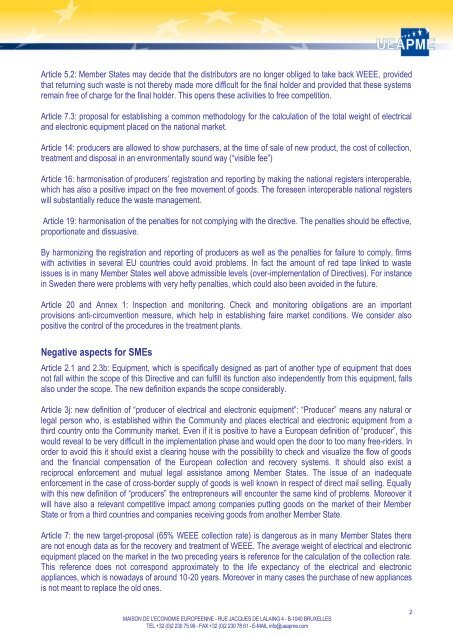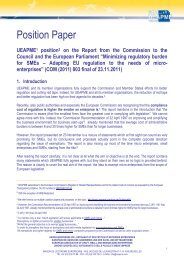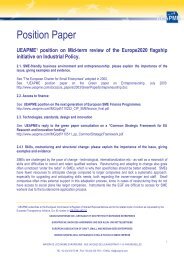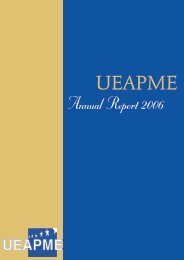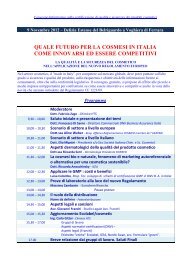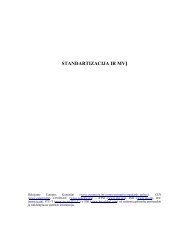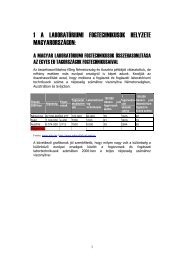Position Paper - UEAPME
Position Paper - UEAPME
Position Paper - UEAPME
You also want an ePaper? Increase the reach of your titles
YUMPU automatically turns print PDFs into web optimized ePapers that Google loves.
Article 5.2: Member States may decide that the distributors are no longer obliged to take back WEEE, provided<br />
that returning such waste is not thereby made more difficult for the final holder and provided that these systems<br />
remain free of charge for the final holder. This opens these activities to free competition.<br />
Article 7.3: proposal for establishing a common methodology for the calculation of the total weight of electrical<br />
and electronic equipment placed on the national market.<br />
Article 14: producers are allowed to show purchasers, at the time of sale of new product, the cost of collection,<br />
treatment and disposal in an environmentally sound way (“visible fee”)<br />
Article 16: harmonisation of producers’ registration and reporting by making the national registers interoperable,<br />
which has also a positive impact on the free movement of goods. The foreseen interoperable national registers<br />
will substantially reduce the waste management.<br />
Article 19: harmonisation of the penalties for not complying with the directive. The penalties should be effective,<br />
proportionate and dissuasive.<br />
By harmonizing the registration and reporting of producers as well as the penalties for failure to comply, firms<br />
with activities in several EU countries could avoid problems. In fact the amount of red tape linked to waste<br />
issues is in many Member States well above admissible levels (over-implementation of Directives). For instance<br />
in Sweden there were problems with very hefty penalties, which could also been avoided in the future.<br />
Article 20 and Annex 1: Inspection and monitoring. Check and monitoring obligations are an important<br />
provisions anti-circumvention measure, which help in establishing faire market conditions. We consider also<br />
positive the control of the procedures in the treatment plants.<br />
Negative aspects for SMEs<br />
Article 2.1 and 2.3b: Equipment, which is specifically designed as part of another type of equipment that does<br />
not fall within the scope of this Directive and can fulfill its function also independently from this equipment, falls<br />
also under the scope. The new definition expands the scope considerably.<br />
Article 3j: new definition of “producer of electrical and electronic equipment”: “Producer” means any natural or<br />
legal person who, is established within the Community and places electrical and electronic equipment from a<br />
third country onto the Community market. Even if it is positive to have a European definition of “producer”, this<br />
would reveal to be very difficult in the implementation phase and would open the door to too many free-riders. In<br />
order to avoid this it should exist a clearing house with the possibility to check and visualize the flow of goods<br />
and the financial compensation of the European collection and recovery systems. It should also exist a<br />
reciprocal enforcement and mutual legal assistance among Member States. The issue of an inadequate<br />
enforcement in the case of cross-border supply of goods is well known in respect of direct mail selling. Equally<br />
with this new definition of “producers” the entrepreneurs will encounter the same kind of problems. Moreover it<br />
will have also a relevant competitive impact among companies putting goods on the market of their Member<br />
State or from a third countries and companies receiving goods from another Member State.<br />
Article 7: the new target-proposal (65% WEEE collection rate) is dangerous as in many Member States there<br />
are not enough data as for the recovery and treatment of WEEE. The average weight of electrical and electronic<br />
equipment placed on the market in the two preceding years is reference for the calculation of the collection rate.<br />
This reference does not correspond approximately to the life expectancy of the electrical and electronic<br />
appliances, which is nowadays of around 10-20 years. Moreover in many cases the purchase of new appliances<br />
is not meant to replace the old ones.<br />
MAISON DE L'ECONOMIE EUROPEENNE - RUE JACQUES DE LALAING 4 - B-1040 BRUXELLES<br />
TEL +32 (0)2 230 75 99 - FAX +32 (0)2 230 78 61 - E-MAIL info@ueapme.com<br />
2


